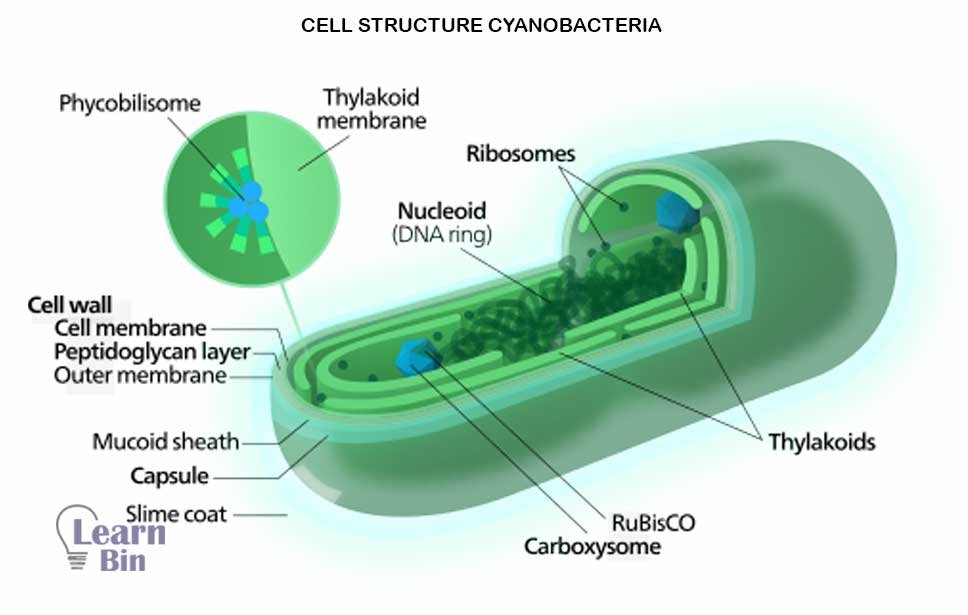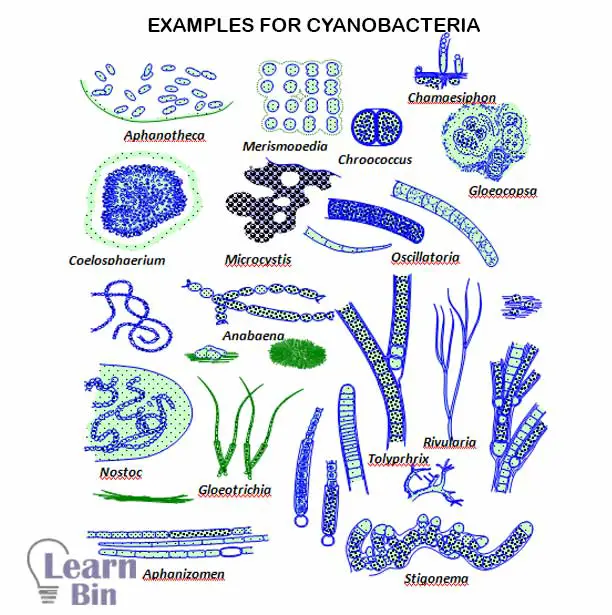More results...


Cyanobacteria are also known as blue-green algae. Though they are called “Blue-green algae”, cyanobacteria are not a type of algae. Cyanobacteria are classified under the bacteria domain, kingdom bacteria. Cyanobacteria (cyanophyta) is a phylum of kingdom bacteria.
They are abundant in aquatic environments. Lives in terrestrial wet habitats and moist surfaces. Some cyanobacteria show symbiotic relationships. Cyanobacteria are common in the form of multicellular colonies and in the form of filaments (filamentous cyanobacteria), filamentous cyanobacteria are covered with a slime coat. It has a raw of cells in it. These filaments contain spatial junctions, akinetes, and heterocysts.
Cyanobacteria can be reproduced asexually by splitting into spatial junctions. Akinetes are dormant cells in filamentous cyanobacteria. Akinetes allow cyanobacteria to survive in harsh and starvation conditions. Heterocyst can be found in nitrogen-fixing bacteria. Heterocyst are spherical cells that fix nitrogen.
Cyanobacteria are single-celled prokaryotic organisms. The cytoplasm of cyanobacteria is covered by a cell membrane, cell wall, and gelatinous coating. Cyanobacteria have a thick cell wall made up of “Murine”. This makes cyanobacteria gram-negative bacteria. There is a gelatinous coating outside of the cell wall. Through the cell membrane, photosynthetic lamellae are formed.
In the cytoplasm there are cell organelles such as 70s Ribosomes, circular DNA, Gas vacuole, phycobilisome (Cyanosome), lipid granules, cyanophycean granules, etc. since cyanobacteria are prokaryotic organisms, there is no organized nucleus. However, the circular DNA (Nucleoid) is located at the center of the cell.
Thylakoids, where photosynthesis occurs in cyanobacteria, lie free in the cytoplasm near the cell periphery. It contains chlorophyll A and carotenoids. Phycobillisomes contain photosynthetic pigments of “Phycocyanin (Blue color)” and “Phycoerythrin (Red color)”. These pigments give cyanobacteria a blue-green color. Cyanobacteria do not have flagella.

Cyanobacteria are photoautotrophic organisms. They produce their own food by using atmospheric CO2 and light energy (Photosynthesis). The photosynthesis process of cyanobacteria takes place in the same way as in green plants. But the food products stored in cyanobacteria are slightly different from green plants. The main stored food in cyanobacteria is Cyanophycean starch.
Ocean phytoplankton is a type of cyanobacteria that is responsible for producing an estimated 50% - 85% of the world's oxygen.
In addition to photosynthesis, many species of cyanobacteria can fix atmospheric nitrogen. Nitrogen fixation is the process by which atmospheric nitrogen (N2) is converted into ammonia or related nitrogenous compounds. Filament cyanobacteria with heterocysts fix atmospheric nitrogen.
Reproduction of cyanobacteria occurs asexually by binary or multiple fission. There is no sexual reproduction in cyanobacteria.

Anabaena is a genus of cyanobacteria. They are filamentous cyanobacteria, and it contains heterocyst and akinetes. Because they have heterocysts, they can fix atmospheric nitrogen. Anabaena is abundant in fresh water and moist soil. Some species form symbiotic relationships with certain plants.
E.g.,
Nostoc can be found in wet soils, wet rocks, freshwater, and rarely in marine habitats. They are filamentous cyanobacteria that form colonies that are covered by a gelatinous sheath. Nostoc contains heterocysts, so they can fix atmospheric nitrogen.
Oscillatoria is filamentous cyanobacteria that can be found in freshwater habitats. Oscillatoria reproduces by fragmentation. They can break into fragments called hormogonia. They do not contain heterocysts and akinetes.
E.g.,

Sciencedirect.com - Cyanobacteria
Britannica.com - Blue-green algae
biologydiscussion.com - Photosynthesis food products and nitrogen fixation in cyanobacteria
Cover Image was designed using an image by Photographer: Barry Rosen, U.S. Geological Survey, Public domain, via Wikimedia Commons - Image of Cyanobacterium Gloeotrichia echinulata stained with Sytox, a green cyanine nucleic acid dye.
Figure 01: Kelvinsong, CC BY-SA 3.0, via Wikimedia Commons
Figure 02: Ahmed A. Issa, Mohamed Hemida Abd-Alla and Takuji Ohyama, CC BY-SA 3.0, via Wikimedia Commons